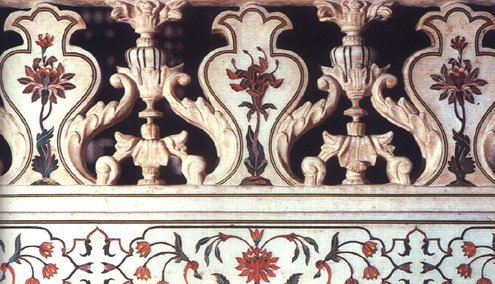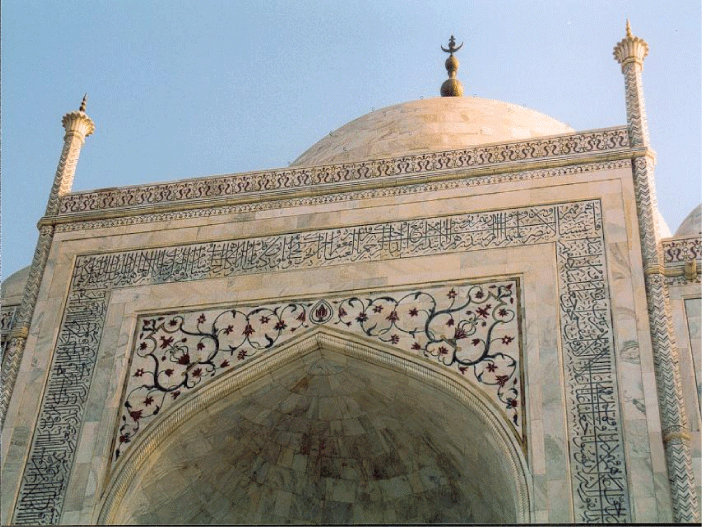


The Taj stands on a raised, square platform (186 x 186 feet) with its four corners truncated, forming an unequal octagon. The architectural design uses the interlocking arabesque concept, in which each element stands on its own and perfectly integrates with the main structure. It uses the principles of self-replicating geometry and a symmetry of architectural elements. The five principal elements of the complex namely the main gateway, garden, mosque, jawab (literally "answer"; a building mirroring the mosque), and mausoleum (including its four minarets)- were conceived and designed as a unified entity according to the tenets of Mughal building practice, which allowed no subsequent addition or alteration.
Its central dome is fifty-eight feet in diameter and rises to a height of 213 feet. It is flanked by four subsidiary domed chambers. These four graceful, slender minarets are 162.5 feet each. The entire mausoleum (inside as well as outside) is decorated with inlaid design of flowers and calligraphy using precious gems such as agate and jasper. The main archways, chiseled with passages from the holy Quran and the bold scroll work of flowery pattern, give a captivating charm to its beauty. The central domed chamber and four adjoining chambers include many walls and panels of Islamic decoration.
Marvin Trachtenberg and Isabelle Hyman in their book "Architecture: from Prehistory to Post-Modernism", have described the Taj Mahal thus:
"The mausoleum of the Taj Mahal at Agra stands in a formally laid-out walled garden entered through a pavilion on the main axis. The tomb, raised on a terrace and first seen reflected in the central canal, is entirely sheathed in marble, but the mosque and counter-mosque on the transverse axis are built in red sandstone. The four minarets, set symmetrically about the tomb, are scaled down to heighten the effect of the dominant, slightly bulbous dome. The mosques, built only to balance the composition are set sufficiently far away to do no more than frame the mausoleum. In essence, the whole riverside platform is a mosque courtyard with a tomb at its center. The great entrance gate with its domed central chamber, set at the end of the long watercourse, would in any other setting be monumental in its own right."
"The interior of the building is dimly lit through pierced marble lattices and contains a virtuoso display of carved marble. Externally the building gains an ethereal quality from its marble facings, which respond with extraordinary subtlety to changing light and weather."
Two notable decorative features are repeated throughout the complex: pietra dura and Arabic calligraphy. As embodied in the Mughal craft, pietra dura incorporates the inlay of semiprecious stones of various colors, such as lapis lazuli, jade, crystal, turquoise and amethyst, in highly formalized and intertwining geometric and floral designs. The colors serve to moderate the dazzling expanse of the white Makrana marble. The level of sophistication in the art work becomes obvious when one realizes that a 3 cm decorative element contains more than 50 inlaid gemstones.
 Under the direction of Amanat
Khan al-Shirazi, Quranic verses were inscribed across numerous sections of the
Taj Mahal in calligraphy, the center of Islamic artistic tradition. One of the
inscriptions in the sandstone gateway is known as Daybreak (89:28-30) and
invites the faithful to enter paradise. Calligraphy also encircles the soaring
arched entrances to the mausoleum proper. On closer look, the lettering of the
Quran verses around the archways appears to be uniform, regardless of their
height. The lettering, spacing and density have been customized to give this
impression to the beholder. To ensure its uniform appearance, the lettering
increases in size according to its relative height and distance from the viewer.
Under the direction of Amanat
Khan al-Shirazi, Quranic verses were inscribed across numerous sections of the
Taj Mahal in calligraphy, the center of Islamic artistic tradition. One of the
inscriptions in the sandstone gateway is known as Daybreak (89:28-30) and
invites the faithful to enter paradise. Calligraphy also encircles the soaring
arched entrances to the mausoleum proper. On closer look, the lettering of the
Quran verses around the archways appears to be uniform, regardless of their
height. The lettering, spacing and density have been customized to give this
impression to the beholder. To ensure its uniform appearance, the lettering
increases in size according to its relative height and distance from the viewer.
As a tribute to a beautiful woman and as a monument for enduring love, the Taj reveals its subtleties when one explores it at leisure and not hurriedly. The rectangular base of Taj is in itself symbolic of the different sides from which to view a beautiful woman. The main gate is like a veil to a woman's face, which should be lifted delicately, gently and without haste on the wedding night. As per the charming Indian tradition the veil is lifted gently to reveal the beauty of the bride, in the couple's first night together.
The dome is made of white marble, but the tomb is set against an awesome backdrop of the river and it is this background that works its magic of colors, and through the reflection of these colors transforms the view of the Taj. The colors change at different hours of the day and during different seasons. Like a jewel, the Taj sparkles in moonlight when the semi-precious stones inlaid into the white marble on the main mausoleum catch the glow of the moon. The Taj is pinkish in the morning, milky white in the evening and golden when the moon shines. These changes, they say, depict the different moods of a woman.
It has been said of the Mughals that they designed like giants and finished like jewelers, a fact amply brought out in the Taj Mahal. The wife of a British officer, Colonel Slleman, while writing home, described it thus:
"I cannot tell what I think. I do not know how to criticize such a building but I can tell what I feel. I would die tomorrow to have such another over me."
The poet Rabindranath Tagore has perhaps said it best of all:
"You know Shah Jahan, life and youth, wealth and glory, they all drift away in the current of time. You strove therefore, to perpetuate only the sorrow of your heart. Let the splendor of diamond, pearl and ruby vanish. Only let this one teardrop, this Taj Mahal, glisten spotlessly bright on the cheek of time, forever and ever."
